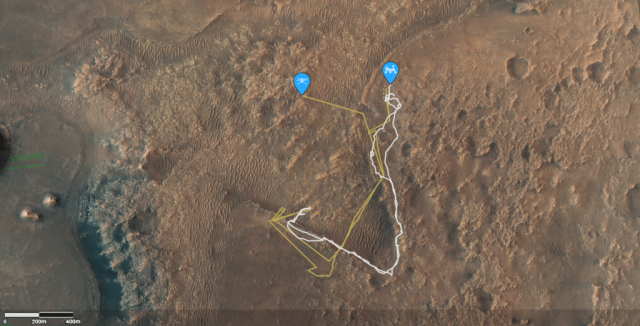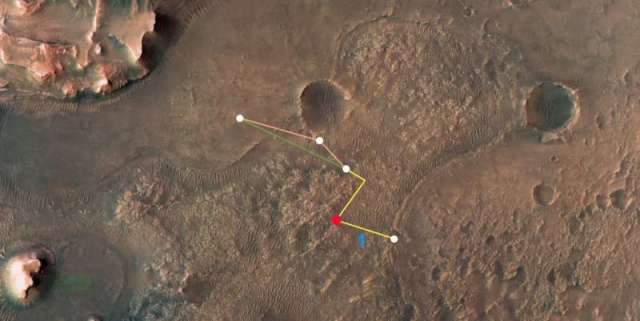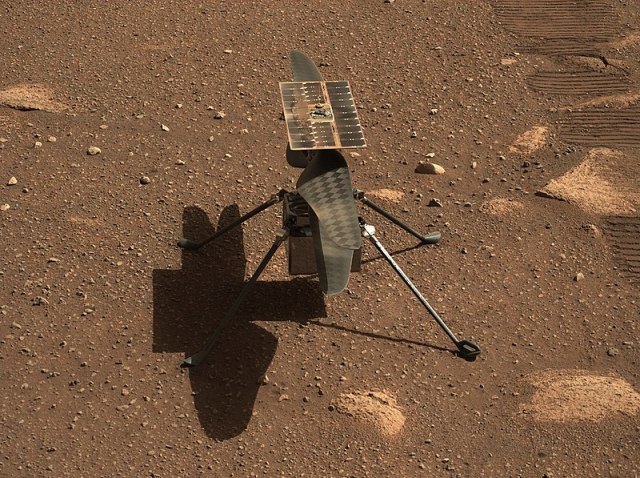Ingenuity will continue to fly on the Red Planet and assist the Perseverance rover mission for at least another six months, until September 2022. Along the way, he will continue to test his capabilities and break records for altitude and duration of flight, which will provide invaluable data for designing the structures of future Martian aircraft.
The National Aeronautics and Space Administration of the United States announced about his decision after the 21st successful flight of the Martian helicopter. It became the first of at least three necessary for the helicopter to cross the northwestern part of the Seita region, which the spacecraft studied in its first year on Mars, and to reach the next area for research — Three Forks in the delta of the dried-up Neretva River.
Ingenuity's new flight area is completely different from the featureless and relatively flat terrain in which it has been operating since its first flight on April 19 last year. A fan-shaped delta several kilometers wide, formed by the ancient Neretva River, rises more than 40 meters above the bottom of the Jezero crater, in the western part of which a pair of robotic vehicles are currently conducting research after landing.
The delta of the former river is filled with jagged rocks, sloping surfaces, protruding boulders and sand pockets, which can become a serious obstacle in the way of the Perseverance rover and the Ingenuity helicopter.
The first one can get stuck in the sand or damage the wheels, and the second one can easily turn over when landing. Nevertheless, the new region should contain numerous geological discoveries - perhaps even evidence of microscopic life that once existed on Mars.

Routes and current locations of the Perseverance rover and the Ingenuity helicopter in the Jezero crater as of Sol 379 (03/15/2022).
Image Source: NASA JPL
Upon reaching the delta, Ingenuity's first task will be to help choose the optimal route for Perseverance to its top, along one of two dried-up riverbeds. In addition, the cameras mounted on the helicopter will help the rover's operator team identify potential scientific targets for soil sampling, survey remote geological objects (outside the visible and passable Perseverance zone) and scout possible landing zones for the program to return samples from Mars.
"The campaign in the delta of the river near the Jezero crater will be the biggest challenge that the Ingenuity team will face since its first flight to Mars," emphasizes Teddy Tsanetos (Teddy Tzanetos), head of the Ingenuity group at NASA's Jet Propulsion Laboratory. —To increase the chances of success, we have increased the size of the team and continued to upgrade the flight software to increase operational flexibility and flight safety."
Some of these updates have led to a reduction in the number of navigation errors during flight, which has increased the safety of both flight and landing. And a recent change in Ingenuity frees it from the previously set maximum lifting height of 15 meters (although the device has not previously risen above 12 meters).
An increase in altitude can lead to a gradual increase in both speed and range. Another update allows Ingenuity to change the speed right in the air and adapt to changes in the terrain.

There are two different routes by which Ingenuity can reach the Neretva River Delta near the Jezero crater. The red dot shows the current position of the helicopter after the 21st successful flight.
Image Source: NASA/JPL-Caltech/University of Arizona/USGS
The next Ingenuity flight, scheduled no earlier than March 19, will be a difficult journey of about 350 meters in length, including a sharp turn in flight to circumnavigate a large hill lying in the path of the helicopter. After that, the team will determine the further route for the final exit from the Seita region. In total, during the entire mission, Ingenuity was in the air for more than 38 minutes and covered almost 4.7 kilometers.
"This upcoming flight will be my 22nd entry in the logbook," concludes Ingenuity Chief pilot Howard Grip from NASA's Jet Propulsion Laboratory. — I remember when it all started, I thought that we would be lucky if we could make three entries there, and very lucky if there were five. Now at this rate I'm going to need a second book."

